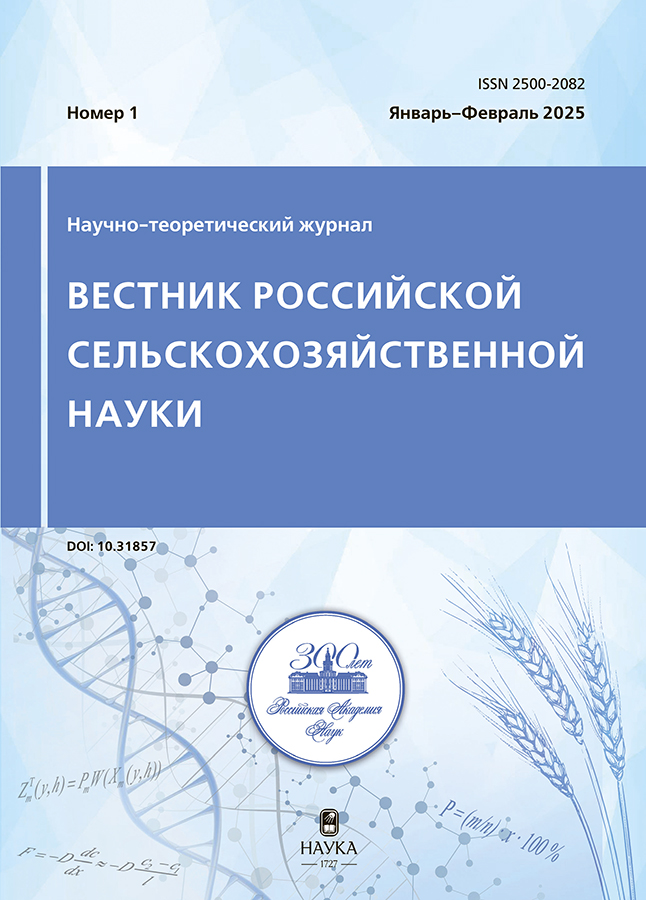Экологические факторы, влияющие на распространение ларвальных цестодозов северного оленя в ЯНАО
- Авторы: Лещёв М.В.1, Гавричкина А.А.1, Гавричкин А.А.1
-
Учреждения:
- Всероссийский научно-исследовательский институт ветеринарной энтомологии и арахнологии – филиал Федерального государственного бюджетного учреждения науки федерального исследовательского центра Тюменского научного центра Сибирского отделения Российской академии наук
- Выпуск: № 1 (2025)
- Страницы: 51-54
- Раздел: Зоотехния
- URL: https://vietnamjournal.ru/2500-2082/article/view/686152
- DOI: https://doi.org/10.31857/S2500208225010116
- EDN: https://elibrary.ru/CSRNNG
- ID: 686152
Цитировать
Полный текст
Аннотация
Оленеводство – основа жизни, уклада и традиций аборигенного населения Крайнего Севера. В результате активного освоения ресурсов Западной Сибири сокращаются площади пригодные для выпаса северного оленя. Уплотнение территорий создает условия для распространения инфекционных и инвазионных заболеваний, которые снижают продуктивность, ослабляют иммунитет, нередко приводят к гибели оленей. Самая многочисленная группа по многообразию возбудителей болезней инвазионной этиологии – паразитические черви класса Cestoda. Ларвальные цестодозы в оленеводческих хозяйствах Крайнего Севера встречаются повсеместно. Цель работы – изучение цистицеркоза северного оленя на территории Ямало-Ненецкого автономного округа для уточнения видового разнообразия и интенсивности поражения. Цистицеркозы вызваны личиночными стадиями цестод и паразитируют на внутренних органах и тканях животных, иногда человека, приводя к острым воспалительным процессам. Основной источник распространения цистицеркоза у оленей – оленегонные собаки, также инвазию передают волки и песцы. Несмотря на значительный вклад ученых и ветеринарных специалистов в изучение данного вопроса, эффективные способы лечения цистицеркоза не найдены. При вскрытии северных оленей на убойных комплексах и в полевых условиях обнаружены личинки трех видов рода Taenia: hydatigena, krabbei, parenchimatosa. Экстенсивность инвазии (ЭИ) паренхиматозного цистицеркоза в среднем по округу – 33,4%. Реже встречался тарандный цистицеркоз при экстенсивности инвазии – 23,7%. Пораженность тениукольным цистицеркозом по районам – 2,4%. Отмечена достоверная разница инвазированности разными видами цистицерков в зависимости от половозрастной группы оленей.
Ключевые слова
Полный текст
Об авторах
Максим Владимирович Лещёв
Всероссийский научно-исследовательский институт ветеринарной энтомологии и арахнологии – филиал Федерального государственного бюджетного учреждения науки федерального исследовательского центра Тюменского научного центра Сибирского отделения Российской академии наук
Автор, ответственный за переписку.
Email: tamaraa111@mail.ru
кандидат ветеринарных наук
Россия, г. ТюменьАлёна Александровна Гавричкина
Всероссийский научно-исследовательский институт ветеринарной энтомологии и арахнологии – филиал Федерального государственного бюджетного учреждения науки федерального исследовательского центра Тюменского научного центра Сибирского отделения Российской академии наук
Email: tamaraa111@mail.ru
младший научный сотрудник
Россия, г. ТюменьАлександр Александрович Гавричкин
Всероссийский научно-исследовательский институт ветеринарной энтомологии и арахнологии – филиал Федерального государственного бюджетного учреждения науки федерального исследовательского центра Тюменского научного центра Сибирского отделения Российской академии наук
Email: tamaraa111@mail.ru
кандидат биологических наук
Россия, г. ТюменьСписок литературы
- Андреев А.А. Особенности распространения гельминтозов среди жителей полярных и приполярных районов // Международный студенческий научный вестник. 2021. № 2. С. 161–161.
- Казановский Е.С. Ветеринарное благополучие северного оленеводства-важный резерв сохранности поголовья и увеличения продуктивности отрасли. Стратегические приоритеты в управлении природноресурсным потенциалом европейского северо-востока и зоны арктики // Аграрная наука Евро-Северо-Востока. 2017. № 4. С. 44–47.
- Коколова Л.М., Гаврильева Л.Ю. Цистицеркозы северных оленей в Якутии // Наука, техника и образование. 2018. № 11 (52). С. 101–103.
- Лещев М.В. Эпизоотология инвазионных болезней северных оленей в Ямало-Ненецком автономном округе. Автореф. дис. … канд. вет. наук. 2008. С. 11–13.
- Меднова Т.В. Исследование мяса оленины на Кольском полуострове // Наука и современность. 2011. № 9-2. С. 35–39.
- Николаев С.В. Характеристика гельминтофауны северных оленей Большеземельской тундры // Аграрная наука на современном этапе развития северных и арктических территорий. Сб. науч. мат. Всерос. науч. конф. с межд. уч., посвящ. 90-летию Нарьян-Марской сельскохозяйственной опытной станции (1932–2022). Нарьян-Мар, 2022. С. 28.
- Пельгунов А.Н., Маклакова Л.П. Паразитологические аспекты, связанные с акклиматизацией и интродукцией диких копытных // Российский паразитологический журнал. 2013. № 3. С. 67–75.
- Почепко Р.А. и др. Эпизоотическая ситуация по цестодовой инвазии домашних северных оленей в оленеводческих хозяйствах Мурманской области // Ветеринария сегодня. 2021. Т. 1. № 1. С. 52–58.
- Якименко Л.В., Иваненко Н.В. Арктическое природопользование: новая парадигма //Территория новых возможностей. Вестник Владивостокского государственного университета экономики и сервиса. 2021. Т. 13. № 2. С. 109–119.
Дополнительные файлы










